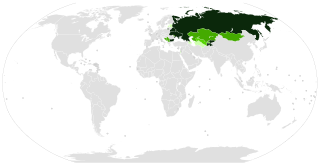The Hungarian alphabet is an extension of the Latin alphabet used for writing the Hungarian language.
Filipinoorthography specifies the correct use of the writing system of the Filipino language, the national and co-official language of the Philippines.
The Greek alphabet has been used to write the Greek language since the late 9th or early 8th century BC. It is derived from the earlier Phoenician alphabet, and was the earliest known alphabetic script to have distinct letters for vowels as well as consonants. In Archaic and early Classical times, the Greek alphabet existed in many local variants, but, by the end of the 4th century BC, the Euclidean alphabet, with 24 letters, ordered from alpha to omega, had become standard and it is this version that is still used for Greek writing today.

The Ukrainian alphabet is the set of letters used to write Ukrainian, which is the official language of Ukraine. It is one of several national variations of the Cyrillic script. It comes from the Cyrillic script, which was devised in the 9th century for the first Slavic literary language, called Old Slavonic. In the 10th century, it became used in Kievan Rus' to write Old East Slavic, from which the Belarusian, Russian, Rusyn, and Ukrainian alphabets later evolved. The modern Ukrainian alphabet has 33 letters in total: 20 consonants, 1 semivowel, 10 vowels and 1 palatalization sign. Sometimes the apostrophe (') is also included, which has a phonetic meaning and is a mandatory sign in writing, but is not considered as a letter and is not included in the alphabet.

Gaj's Latin alphabet, also known as abeceda or gajica, is the form of the Latin script used for writing Serbo-Croatian and all of its standard varieties: Bosnian, Croatian, Montenegrin, and Serbian.
A letter is a segmental symbol of a phonemic writing system. The inventory of all letters forms an alphabet. Letters broadly correspond to phonemes in the spoken form of the language, although there is rarely a consistent and exact correspondence between letters and phonemes.

Wolofal is a derivation of the Arabic script for writing the Wolof language. It is basically the name of a West African Ajami script as used for that language.
There are various systems of romanization of the Armenian alphabet.

Numerous Cyrillic alphabets are based on the Cyrillic script. The early Cyrillic alphabet was developed in the 9th century AD and replaced the earlier Glagolitic script developed by the Byzantine theologians Cyril and Methodius. It is the basis of alphabets used in various languages, past and present, Slavic origin, and non-Slavic languages influenced by Russian. As of 2011, around 252 million people in Eurasia use it as the official alphabet for their national languages. About half of them are in Russia. Cyrillic is one of the most-used writing systems in the world. The creator is Saint Clement of Ohrid from the Preslav literary school in the First Bulgarian Empire.
The Fula language is written primarily in the Latin script, but in some areas is still written in an older Arabic script called the Ajami script or in the recently invented Adlam script.
The Woleai or Caroline Island script, thought to have been a syllabary, was a partially Latin-based script indigenous to Woleai Atoll and nearby islands of Micronesia and used to write the Woleaian language until the mid-20th century. At the time the script was first noticed by Europeans, this part of Micronesia was known as the Caroline Islands, hence the name Caroline Island script.

A writing system is a method of visually representing verbal communication based on a script and an orthography or set of rules regulating its use.
Raga is the language of northern Pentecost Island in Vanuatu. Like all Vanuatu languages, Raga belongs to the Oceanic subgroup of the Austronesian languages family. In old sources the language is sometimes referred to by the names of villages in which it is spoken, such as Bwatvenua (Qatvenua), Lamalanga, Vunmarama and Loltong.

A number of writing systems have been used to transcribe the Somali language. Of these, the Somali Latin alphabet is the most widely used. It has been the official writing script in Somalia since the Supreme Revolutionary Council formally introduced it in October 1972, and was disseminated through a nationwide rural literacy campaign. Prior to the twentieth century, the Arabic script was used for writing Somali. An extensive literary and administrative corpus exists in Arabic script. It was the main script historically used by the various Somali sultans to keep records. Writing systems developed locally in the twentieth century include the Osmanya, Borama and Kaddare scripts.
Ske is an endangered language of south-western Pentecost island in Vanuatu. Ske is an Oceanic language.

The Turaga nation is an indigenous movement based in northern Pentecost Island, Vanuatu. Its leader is Chief Viraleo Boborenvanua, and it has also been associated with Motarilavoa Hilda Lin̄i. The organisation has its headquarters in the traditional village of Lavatmanggemu on the north-east coast of Pentecost.

Kulitan, also known as súlat Kapampángan and pamagkulit, is one of the various indigenous suyat writing systems in the Philippines. It was used for writing Kapampangan, a language mainly spoken in Central Luzon, until it was gradually replaced by the Latin alphabet.
The Adlam script is a script used to write Fulani. The name Adlam is an acronym derived from the first four letters of the alphabet, standing for Alkule Dandayɗe Leñol Mulugol, which means "the alphabet that protects the peoples from vanishing". It is one of many indigenous scripts developed for specific languages in West Africa.
The Sunuwar Alphabet is an alphabet developed by Krishna Bahadur Jentich in 1942, to write the Sunwar language, a member of the Kiranti language family spoken in Eastern Nepal, as in Sikkim. It is recognised in Sikkim and used as an official writing system. The alphabet has 33 letters, 10 numerals and 1 'auspicious sign'.











